Growing Radishes in Containers and Pots is easy and quick, and you can enjoy the best-tasting crispy homegrown radishes without having a garden.
Radishes belong to the Brassicaceae family, just like cauliflower, broccoli, mustard, cabbage, and turnip. Because it is easy to grow and harvest them quickly, they are a popular cool weather crop among gardeners.
Growing radishes in containers is not difficult as well in a limited space. You can enjoy fresh and crispy radishes and tasty green tops right in your apartment balcony, patio, porch, rooftop, or even indoors on your window sill.
Also Read: Growing Beets in Pots
If you’ve grown other root vegetables previously, this is not much different. After reading this post, you’ll learn how to grow radishes in pots easily!
Botanical Name: Raphanus sativus
USDA Zones: All, Planting times may differ.
How to Grow Radishes in Pots
The most common way of propagating radishes is from seeds. As they are quite common, you’ll be able to get seeds of all the radish varieties in a garden shop or online.
- Instead of sowing radish seeds in seed trays, plant them directly in the desired pots.
- Sow the seeds 1/4 or 1/2 inch deep and 1 inch apart into the potting medium and gently cover them back with the mix.
- Between 3 to 10 days, the seeds will germinate, and tiny plants will emerge.
- Thin out the seedlings, so they are only two inches apart. No need to throw away the thinned greens. They make a delicious and nutritious addition to salads and other microgreens.
- If you’re growing large radish varieties like daikon, space the seedlings 3-4 inches apart.
NOTE: For the harvest to last longer, do succession planting and resow the seeds every 2 weeks, if you’ve space available.
When to Plant Radishes
Start your radish seeds in spring when the soil temperature is above 40 F (5 C), and the weather starts to warm up. Even if the weather is not favorable, you can easily plant the radish seeds indoors in early spring and continue to do so every other week for a regular harvest. Keep growing radishes till early summer and stop. Then, again, begin planting from late summer or early fall (autumn) till early winter.
If you’re not living in hot subtropical and tropical climate, growing radishes in pots in summers is also possible. Sow seeds of summer varieties and take advantage of the microclimate you can create by container gardening. Water summer radishes more often and change location to save them from the intense afternoon sunlight.
In hot, frost-free climates, begin planting radishes in containers from late fall or early winter and continue planting successively throughout the winter.
Note: Radishes grown in high temperatures are usually spicier.
Types of Radishes
Radishes come in many shapes, sizes, and colors. There are round radishes like pink beauty, cherry belle (the most common one), cherriette, Easter egg, early scarlet globe–Some of the popular varieties that mature within 3-5 weeks.
Then, there are elongated ones like French breakfast that taste so crispy and juicy, perfect for munching. If you crave for unique-looking radishes, grow the watermelon radish or select a black radish variety, black radishes have a stronger flavor than other types of radishes.
Icicle radishes come in a cylindrical shape, more like carrots but white in color and 5-6 inches long, they must not be confused with daikons.
Daikons are large-sized white-colored radishes, sweet and crispy with a hint of mild peppery flavor like mustard. If picked late, the peppery flavor becomes intense and spicy, and daikons become woody. The same is the case with all the radish types.
Tip: Learn about more radish varieties in this article.
Container Size for Growing Radishes & Spacing
Choosing a pot for growing radish depends upon the radish variety you’re growing. Wide and shallow windowboxes and troughs are most suitable for this purpose.
- Select a pot that is at least 6 inches deep for most regular radish varieties like Cherry Belle, Purple Plum, and Easter Egg. These radish varieties take 3-5 weeks to reach the harvesting period after planting.
- Most radishes don’t require more than two inches of spacing.
- However, some large varieties, such as white radishes “Daikon,” are long and require a deep 12-14 inches pot and 3 to 4 inches of spacing.
- The diameter of the pot for both small and large varieties depends on the number of radishes you are planning to have.
- If your pot is 12 inches wide, you can grow 6-7 plants of usual radish varieties in it. In a similar pot, you can grow 4 radish plants of large varieties.
Also Read: How to Grow Homegrown Carrots in Small Space
Requirements for Growing Radishes in Containers
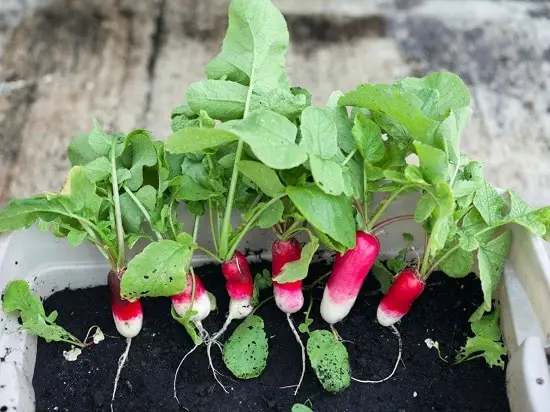 Location
Location
Grow radishes in a sunny location, 6-8 hours of direct sunlight is essential for optimum growth. It can also grow in part sun (around 4-5 hours), but lack of sunlight results in slow growth. Although, if you’re growing radish in a hot climate or summers, you can easily grow this root vegetable in part sun.
Soil
Radishes prefer rich, well-drained, and permeable soil that doesn’t obstruct root growth. For that, buy a quality potting mix or make your own. The one you make should be loamy than clayey and have no stones. Additionally, you can add a handful or two of compost or well-rotted manure in your potting mix at the time of planting container radishes.
Improve Moisture Retention in Soil in Windy & Hot Location
If your balcony, patio, or rooftop is windy or you’re growing radishes in railing planters, it’s better to improve the moisture-retaining capacity of the potting soil. You can add any of these organic materials like peat moss, compost, aged manure, or coconut coir. Using perlite or vermiculite is also an option.
Also Read: Balcony Railing Planter Ideas
Watering
Temperature
Radish is a cool-season crop that grows best in short days. The minimum seed germination temperature is 40 F (5 C), and the maximum is 95 F (35 C). The optimum seed germination temperature falls in the range of 55-85 F (13-30 C). Below or above this, seeds germinate slowly.
The most flavorful and crispiest radishes grow in moderately cool temperatures, which is 50-70 F (10-21 C). You can grow radish in the temperature range of 40 F (5 C) to 90 F (32 C) without much difficulty.
Also Read: Best Root Vegetables for Container Gardeners
How to Care for Radishes
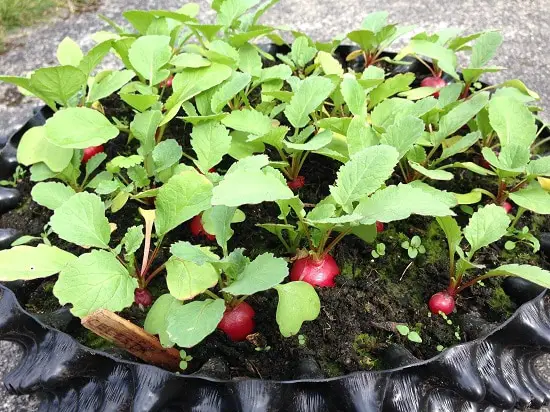 Radish Fertilizer
Radish Fertilizer
- At the time of planting, mix slow-release fertilizer in the potting soil. If you’re an organic gardener, add one-third part compost or aged manure in the soil instead of the granular fertilizer.
- As too much nitrogen can cause foliage growth and lush radish tops, it’s better to feed radishes with low nitrogen formula like 5-10-10. You can also feed with general purpose fertilizer like 20-20-20–if the above or similar NPK ratio is not available.
- Once your radishes are two weeks old and not performing well, you can fertilize again with a weak dose of water-soluble fertilizer.
- Also, if you missed adding anything at planting time, fertilize your radishes regularly every 10-14 days with a 5-10-10 or 5-10-5 water-soluble fertilizer.
Pests and Diseases
Container grown radishes have no major pests or diseases problem. But aphids and flea beetles might irk you. Wash aphids with a blast of water or use insecticidal soap.
In diseases, downy mildew can affect your plants. To avoid, provide proper air circulation and don’t keep the foliage wet.
Harvesting Radishes
- Early maturing radish cultivars can be harvested within 20-40 days after planting. Some varieties, such as Cherry Belle and French Breakfast, are ready for harvest in 23-30 days.
- Asian radish varieties like daikons take 60-70 days to reach maturity.
- Be vigilant when it comes to harvesting radishes. Waiting too long can turn radishes woody, cracked, and peppery.
- Not just the radish roots, you can also harvest radish tops. Harvest the young and green leaves to use in salads and soups or prepare exotic recipes.
- Let a few of your radish plants flower and set the seed pods as these pods are also edible
Frequently Asked Questions
How Many Radishes to Plant for Sufficient Yield?
It depends on how much you consume and how many members are there in your family. On average, grow 12-15 radishes per person every month. You’ll need a single 24 inches wide windowbox for that.
Can You Grow Radish Indoors?
Yes, growing radish indoors is fairly easy, and this way, you can savor year-round homegrown radishes. Get a couple of long rectangular pots and sow the seeds directly and wait for seedlings to emerge. If one of your windows receives 5-6 hours of direct sunlight, you’re all set. All the growing requirements are similar, but you’ll need to be careful about watering.


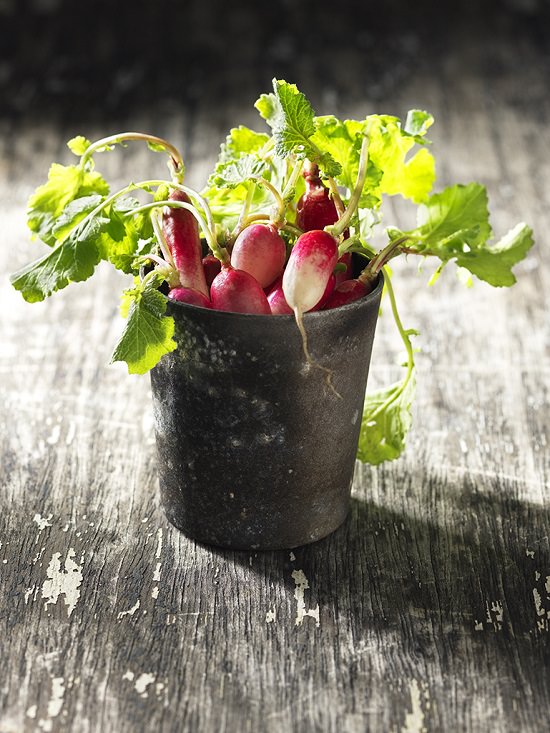
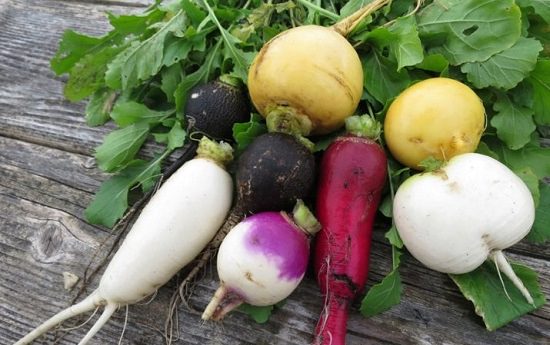
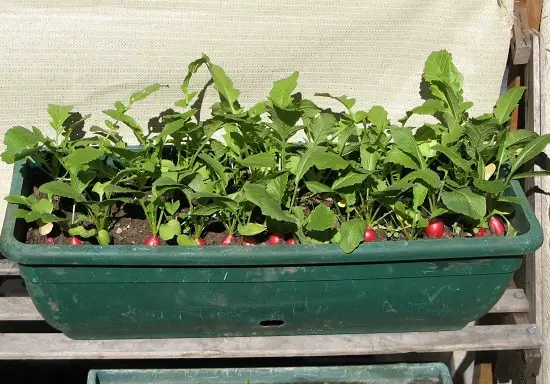


I just sowed some seeds in a pot. How often should I water? Once a day?
Hi!, I just wanted to ask if it was alright if I use your videos for writing my new children’s book. Of course, I’ll properly cite it and encourage my readers to check out your great website. Please reply soon. Thank you
* I meant website pages, not videos
Reply for Steven, Water just often enough to keep the soil feeling damp. Container size, regional climate, and even the soil itself will affect how often you need to water. Soil should not reach the point of feeling dry. Soil shouldn’t stay muddy after watering either. Muddy conditions mean allows no air circulation for the roots, which can starve the plant and allow disease to weaken the plant further. Dry soil won’t let roots take up nutrients. If you’re in a wet climate, the soil will stay moist for a long time. If you live in a very dry climate, you might need to water very frequently to maintain a damp soil. If you have a small container like a flower pot, it might dry out quickly. If you have a large area of soil, like a barrel or a garden plot, that may retain moisture for a longer while. If soil contains a lot of sand or perlite or vermiculite, it might dry out quicker. If you touch the top of the soil and it feels damp and like it contains some moisture but it can still crumble and not be mud, your radishes should stay happy. Water to maintain that and you’ll be doing well.
I am trying to grow watermelon radishes but they don’t want to get a bulb. It’s all root what am I doing wrong
I’ve tried planting radishes in large flower pots on my deck two years in a row now and the first year I didn’t thin them out but this last year I planted specifically 2 inches apart. Both years I’ve gotten nothing but skinny roots – no bulb. We’ve had lots of rain here, so I haven’t watered them “every” day. I’ve used good drainage soil and don’t understand why I’m not getting a typical radish. They were planted in late April.